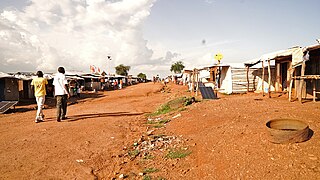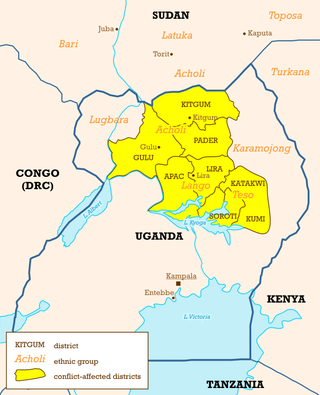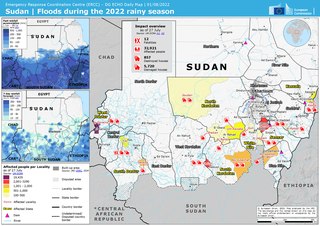Related Research Articles
Sudanese refugees are people originating from the country of Sudan, seeking refuge outside the borders of their native country. In recent history, Sudan has been the stage for prolonged conflicts and civil wars, as well as environmental changes, namely desertification. These forces have resulted not only in violence and famine but also the forced migration of large numbers of the Sudanese population, both inside and outside the country's borders. Given the expansive geographic territory of Sudan, and the regional and ethnic tensions and conflicts, much of the forced migration in Sudan has been internal. Yet, these populations are not immune to similar issues that typically accompany refugeedom, including economic hardship and providing themselves and their families with sustenance and basic needs. With the creation of a South Sudanese state, questions surrounding southern Sudanese IDPs may become questions of South Sudanese refugees.
South Sudanese refugees are persons originating from the African country of South Sudan, but seeking refuge outside the borders of their native country. The world's youngest independent country has a recent and troubled history of prolonged conflicts and ecosystem mismanagement such as overlogging, which has led to desertification. These forces have resulted not only in violence and famine, but also the forced migration of large numbers of the population, both inside and outside the country's borders. South Sudan was cited as the largest refugee crisis in 2016, being the world's third largest, followed by Syria and Afghanistan. As of 2022, the UNHCR estimated that there were 2.4 million refugees under its mandate originating from South Sudan, making the country the fifth largest source of refugees.

Rhino Camp Refugee Settlement is a refugee camp located in the districts of Madi-Okollo and Terego District in North Western Uganda.

Bidibidi Refugee Settlement is a refugee camp located in Yumbe District's West Nile sub-Region in Uganda. It is one of the world’s largest refugee settlements, housing approximately 285,000 refugees fleeing conflict in South Sudan as of late 2016. In 2017, and refugees from DR congo. it was described as the largest refugee settlement site in the world, and in 2023, it was labeled "Africa’s largest refugee camp" by The Guardian.

Qatar–Sudan relations are the bilateral relations between the State of Qatar and the Republic of the Sudan. Relations were first established in 1972, when Qatar inaugurated its embassy in Sudan's capital city, Khartoum. Both countries are members of the Organisation of Islamic Cooperation and Non-Aligned Movement.

Uganda is one of the largest refugee-hosting nations in the world, with 1,529,904 refugees. The vast influx of refugees is due to several factors in Uganda's neighboring countries, especially war and violence in South Sudan and the Democratic Republic of the Congo, and associated economic crisis and political instability in the region. Uganda has relatively 'friendly' policies that provide rights to the refugees, such as rights to education, work, private property, healthcare and other basic social services.
The Palorinya Refugee Settlement is a refugee camp in the Moyo District of the Northern Region of Uganda. The majority of the population fled the civil crisis in South Sudan in 2016.
Mungula II Refugee Settlement is a refugee camp found in Adjumani District Itirikwa subcounty in Northern Uganda.
Mungula refugee settlement is located in Adjumani district in northern Uganda on the border with South Sudan.
Ayilo 2 refugee settlement is one of the refugee camps in Adjumani District in the Northern Region of Uganda.

The Maaji refugee settlements are three refugee camps located in Adjumani District in the Northern Region of Uganda, established in 1997. In June 2018, there were 41,764 registered refugees, accounting for 10% of the district's total population. It has primarily admitted refugees from the Second Sudanese Civil War and the ongoing South Sudanese Civil War. The settlements have been attacked several times by the Lord's Resistance Army, along with other camps in the region such as the Baratuku refugee settlement.

Terego is a district in Uganda's Northern Region. It is located approximately 360 kilometres (220 mi) northwest of Uganda's capital Kampala. The administrative centre of the district is the trading centre of Leju in Aii-Vu Sub-County. Terego District covers an area of 1,102 square kilometres (425 sq mi) and the areas now making up the district recorded a non-refugee population of 199,303 in the 2014 Ugandan census. Terego District also hosts an estimated 168,000 refugees, mostly from South Sudan, in the Imvepi Refugee Settlement and the western zones of the Rhino Camp Refugee Settlement in the district.

The 2022 Sudan floods saw the figure for flood-affected people in Sudan had exceeded the figure for 2021, rising to 314,500. From 2017 to 2021, there were 388,600 people affected by floods annually.
Bambasi Refugee Camp is a refugee camp in Ethiopia.
Ayilo 1 refugee settlement is a prominent refugee camp located in Adjumani District, situated in the Northern Region of Uganda.
Ifo Refugee Camp is a refugee camp in Dadaab in Kenya. It was established in 1991 with initial goal of accommodating refugees from Somalia due to the civil war which was ongoing.

Kakuma Refugee Camp is a refugee camp located in northwestern Turkana County, Kenya. It was established in 1992 to host unaccompanied minors who had fled the war in Sudan and from camps in Ethiopia. The camp is situated in the second poorest region in Kenya and as a result of this poverty, there are ongoing tensions between the refugees and the local community that has occasionally resulted in violence.

Kalobeyei Refugee Settlement, also known as Kalobeyei Integrated Settlement, is a refugee camp located in Turkana County, Kenya. The settlement was established in 2015 to accommodate the growing number of South Sudanese refugees who fled their country due to the conflict that broke out in December 2013.
Throughout 2024, the population of Sudan suffered from severe malnutrition and human-made famine conditions as a result of the Sudanese civil war beginning in 2023, primarily in Darfur, Kordofan, and neighboring refugee-taking nations such as Chad. Famine conditions were caused in part by deliberate attempts by the Rapid Support Forces (RSF) to siege and loot cities with civilians trapped in them and by both sides blocking off supply routes to allow food and humanitarian aid to flow through. On 1 August, the Global Famine Review Committee released a report officially declaring that there was a high risk of IPC Phase 5 famine conditions ongoing throughout internally displaced persons (IDP) camps in Darfur near Al-Fashir. Over 900 deaths have been caused by the famine and over 9 million people have been displaced as a result of the famine and war.
References
- 1 2 3 "Uganda's fourth refugee settlement opens, country responding to unprecedented refugee crisis". www.wvi.org. Retrieved 2023-11-11.
- 1 2 Rhino Camp Refugee settlement extension Omugo zone masterplan. United Nations High Commissioner for Refugees (published 2019-04-11). 2019. p. 1.
- ↑ "Uganda Refugee Response Monitoring Settlement Fact Sheet: Rhino Camp (January 2018) - Uganda | ReliefWeb". reliefweb.int. 2018-06-28. Retrieved 2023-11-11.
- ↑ "Invisible: Disabled people fleeing South Sudan violence tell of significant challenges in Uganda refugee camps". Invisible: Disabled people fleeing South Sudan violence tell of significant challenges in Uganda refugee camps. Retrieved 2023-11-11.
- ↑ Amute, Darwin (2023-03-13). "Step UP!-Project Change Stories PALM Corps". PALM Corps. Retrieved 2023-11-11.
- 1 2 3 4 5 "Uganda Refugee Response Monitoring Settlement Fact Sheet: Rhino Camp (January 2018) - Uganda | ReliefWeb". reliefweb.int. 2018-06-28. Retrieved 2023-11-11.